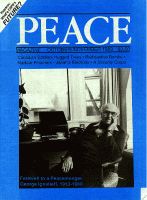
Peace Magazine Oct-Nov 1989, page 7. Some rights reserved.
Search for other articles by Mary-Wynne Ashford here
Environmental disasters are now more threatening than the prospect of foreign invasion. Dr. Ashford advocates allocating a ponion of our armed forces towards protection from such threats.
For forty years, safeguarding Canadian Security has meant maintaining armed defences against the Soviets. Now, however, environmental disasters are more ominous than foreign invasion -- and Canada is unprepared for these threats.
We should have an environmental corps, a fourth paid service under the Department of Defence, equivalent to the Army, Navy or Air Force. Response to disaster requires clear lines of authority, skilled teams, independent communications systems, and specialized equipment located at strategic bases. The Emergency Response Corps would not be armed.
The Training Program
Training would include many skills now taught in the Armed Forces, such as parachuting, search and rescue, communications, and such trades as electrical work to restore power after a hurricane or an earthquake, and to provide emergency generators for medical equipment and lights. All members would be trained in Advanced Industrial First Aid plus immediate care of crush, blast, and burn injuries. Medical and paramedical units would include physicists, and chemists trained to deal with nuclear and chemical accidents. Survival skills, e.g. mountain rescue and undersea diving, should be taught to all recruits. Arctic and wilderness survival should be taught by the native people in such bases as Goose Bay.
Just as firemen are now trained in new techniques of dispute resolution, this team should be trained in conflict resolution. In the stress of disasters, irrational behavior is common. This Force would set up programs with the civilian sector to use volunteers effectively in disasters.
Terrorists also present new threats to our security. It is technically possible for a terrorist to poison water supplies or food sources, and to carry out nuclear terrorism. The RCMP trains experts to deal with terrorists, and in a civil disaster the Emergency Response Corps would collaborate with them.
Equipment and Personnel
Besides the equipment now in use (e.g. helicopters, Bailey bridges, cranes, and mobile hospitals) specialized equipment is needed: booms to contain ocean spills, oil slicker ships, decontamination equipment, robots to send into radiation zones, and vehicles that minimize damage to the environment. Equipment must be strategically located across the country to reduce the time required for effective response.
A Canadian Environmental Disaster Corps could be made available through the U.N., as our Peacekeeping Forces are. Teams sent to a catastrophe in another country may improve their techniques, which can then be applied back at home.
Young people aged 18 and 25 could enlist in the corps and, after their initial service, could continue or return to civilian life. A Reserve Corps would regularly update and increase their competence. In time of disaster, they could be called up from computer lists and sent to the site. Young people could join a Reserve Officer Training Program and pursue a university degree in exchange for serving during their summers and after graduation.
High school students could train as cadets after school and in summers. Many young people, despairing of the future of the world, are turning to drugs and alcohol. Yet they are as patriotic as were those who gave their lives to save their country. They would respond with enthusiasm to the opportunity to address the real dangers to their country.
Benefits
These young men and women would become role models to younger students, demonstrating the courage and physical fitness of our police, fire and armed forces. But in working for the environment, they would be closer to the values of today's youth.
Such a Corps would challenge young people with adventure in their early adulthood. Perhaps the greatest benefit would be the increased peace of mind of all Canadians. Knowing that a force was always prepared for catastrophes would surely add to our security.
Prevention is a part of emergency preparedness. Members of the Corps would offer specialized training programs to industry, fire, and police departments, and to volunteers. They would integrate their work with such non-governmental organizations as the Sierra Club, S.P.C.A., and the Provincial Association of Biologists.
Canadian surveillance of its offshore waters would be enhanced by the Corps training and exercises added to the existing actions of the Coast Guard, the R.C.M.P. and Department of Fisheries and Oceans. This additional coastal presence would deter illicit drug traffic, illegal fishing, and dumping of noxious wastes, and would assert Canadian sovereignty.
The Department of Defence has the expertise of military personnel to establish an Emergency Response Corps. Issues of mandate and jurisdiction must be resolved long before a disaster. Let us examine our existing emergency response capability, and then create such a corps -- a model for the world.
Dr. Ashford is President, Canadian Physicians for the Prevention of Nuclear War.

Peace Magazine Oct-Nov 1989, page 7. Some rights reserved.
Search for other articles by Mary-Wynne Ashford here